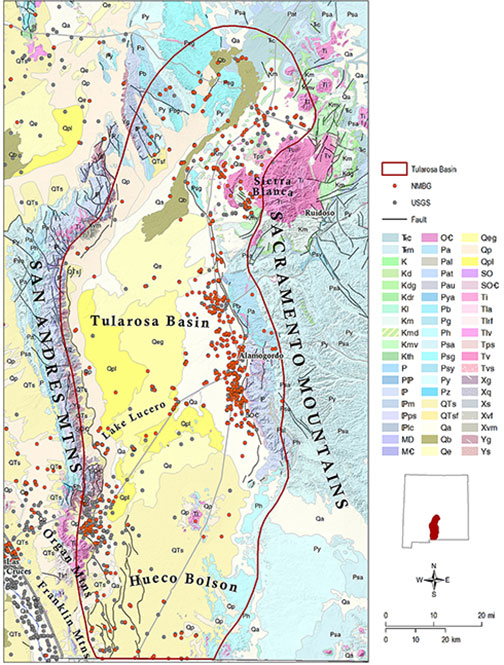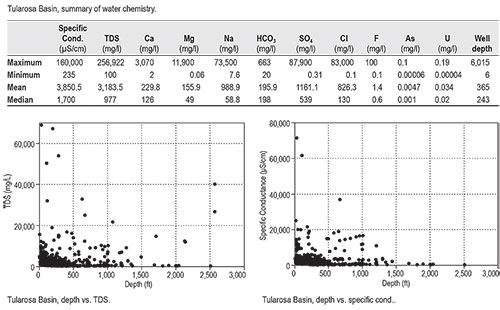
Overview of Fresh and Brackish Water Quality - Tularosa Basin


The Tularosa Basin is an elongate, north-trending intermontane basin of the greater Rio Grande Rift system, occupying approximately 6,500 square miles in south-central New Mexico. The basin is bordered by Sierra Blanca and the Sacramento Mountains to the east; and the San Andres, Organ, and Franklin Mountains to the west. The basin merges to the south with the Hueco Bolson, extending into west Texas. Extensive fault systems with several thousand feet of vertical displacement separate the basin from the east and west-flanking uplifts (Lozinsky and Bauer, 1991). As regional uplift progressed, concurrent erosion of the surrounding highlands has resulted in deposition of more than 6,000 feet of alluvial basin-fill material, consisting of unconsolidated to weakly-cemented gravel, sand, silt and clay deposited in a series of coalescing alluvial fans around the margins of the basin. The basin fill is underlain by consolidated bedrock, thought to consist largely of Paleozoic carbonates.
The Tularosa Basin is one of the few rift basins in the state with internal drainage (Meinzer and Hare, 1915; McLean, 1970), a factor that has a profound impact on quality of water resources in the region. Much of the area is desert or semi-desert, with mean annual rainfall ranging from 10 inches/year in the basin proper to ~30 inches/year in the adjacent Sacramento Mountains. The basin is in many respects typical in terms of water resources in New Mexico. It has, on the one hand, very limited access to potable surface water. No major rivers flow through the Tularosa Basin, and the only available surface water supplies are from springs, small streams, and artificial reservoirs in the Sacramento Mountains. On the other hand, the basin contains several million acre-feet of groundwater in the basin-fill aquifer system. However, over 90% of that groundwater is too saline for human consumption (McLean, 1970; Orr and Myers, 1986). Little is known of the underlying bedrock aquifers since very few boreholes have penetrated the entire section, although records from exploratory wells indicate that water contained in those bedrock aquifers is highly mineralized (>10,000 mg/l; McLean, 1970).
Recharge of the basin-fill aquifer system occurs primarily by infiltration from ephemeral streams that drain the surrounding mountains and discharge across the permeable alluvial fan material. Regional flow of groundwater on the east side of the basin is to the south and west, away from the Sacramento Mountains (Huff, 2002). Surface flood water that makes it past the alluvial fans flows into the interior of the basin and evaporates, depositing dissolved solids in playas, with very little infiltration occurring (McLean, 1975). Saline waters contained in low-permeability playa deposits in the center of the basin are poorly flushed and highly concentrated by evaporation, approaching saturated sodium chloride brine in some areas (McLean, 1975).
On a basin-wide scale, salinity of groundwater in the alluvial fill is assumed to increase toward the center of the basin and with increasing depth. Significant volumes of fresh water are confined to narrow zones a few miles wide next to the mountains on the east and west sides of the basin. In those areas, thickness of the freshwater section ranges from several hundred feet in alluvial fan deposits adjacent to the mountain front to an irregular feather edge toward the basin center. In addition to the basinward increase in salinity, mineral content of groundwater on the east side of the basin increases from south to north, a phenomenon related to the greater abundance of Paleozoic evaporites in the drainage areas of mountain streams in the northern Sacramento Mountains (McLean, 1975).
Between the extremes of fresh water and brine, slightly saline water (<3,000 mg/l) occurs throughout much of the Tularosa Basin in a transition zone that lies basinward of, and beneath the freshwater wedge (McLean, 1970; 1975). The largest volumes of slightly saline water occur in alluvial fill adjacent to the mountain front north and south of Tularosa. However, the position and thickness of the transition zone are highly variable and not well-constrained, because most wells in the basin tap only a small fraction of the saturated thickness of alluvial fill (Garza and McLean, 1977). In some areas, evaporation from the shallow water table will produce a near-surface zone of variable salinity, where more saline water may locally overlie fresh water. Efforts to more precisely characterize the freshwater-saltwater transition zone are complicated by the heterogeneity of the basin-fill aquifer, the irregular distribution of wells, and the limited number of wells that penetrate the more saline portions of the basin fill.
A substantial data set is available for the Tularosa Basin, with 959 total records. Basin-wide mineral content is very high, with a mean TDS of almost 4,000 mg/l. The highest concentrations of dissolved solids are from shallow wells near the center of the basin – for example, the basin-wide maximum TDS is 256,922 mg/l from a well only 15 feet deep on the southwest margin of Lake Lucero. In general, these high salinity values reflect the high concentration of salts in playas near the center of the basin, and are not representative of water quality at greater depths. The deepest well in our records, 6,015 feet below ground level, is located east of White Sands Missile Range Headquarters on the west side of the basin, near the toe of one of the large alluvial fans emerging from the Organ Mountains. TDS content in that well is reported to be only 543 mg/l. Although previous regional studies of the hydrology of the Tularosa Basin (e.g., McLean, 1970) suggest that large reserves of brackish groundwater occur at greater depths, this conceptual model is not supported by our data set. As discussed above, the absence of evidence for a deep brackish water resource is primarily due to the fact that very few wells have penetrated the deeper portions of the basin-fill aquifer. In fact, mean well depth in our records is only 365 feet. Evidence from a few deep exploratory wells indicates that brackish water is also present in the underlying Paleozoic bedrock, but that resource remains almost entirely unexplored.
The data show elevated levels of uranium in groundwater in the Tularosa Basin, with a mean value 0.034 mg/l, slightly higher than the EPA MCL of 0.3. The highest uranium concentrations in the basin occur in wells north of White Sands Missile Range Headquarters, in an alluvial fan on the east flank of the Organ Mountains.
This project is funded by the New Mexico Environment Department, Drinking Water Bureau, under Source Water Protection.
For more information:
see: Overview of Regional Brackish Water Assessments
or contact:
Lewis Land — Hydrogeologist, lland@nckri.org
References
- Land, Lewis, 2016, Overview of Fresh and Brackish Water Quality in New Mexico - Tularosa Basin, Project Summary Sheet.
- Land, Lewis, 2016, Overview of Fresh and Brackish Water Quality in New Mexico, New Mexico Bureau of Geology Mineral Resources, Open-file Report, v. 0583, pp. 55.



